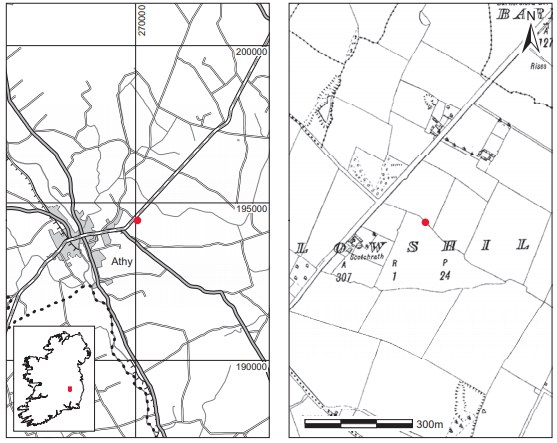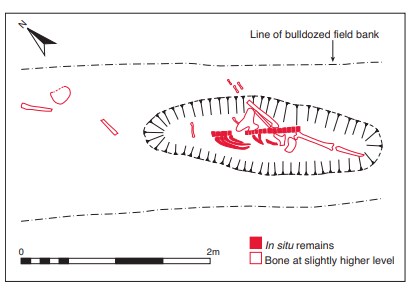County: Kildare Site name: GALLOWSHILL, CO. KILDARE
Sites and Monuments Record No.: N/A Licence number: E1081
Author: MICHAEL RYAN
Site type: Iron Age and early medieval graves, c. 300 BCc. AD 1200
Period/Dating: —
ITM: E 670002m, N 694482m
Latitude, Longitude (decimal degrees): 52.996485, -6.957206
Introduction
In May 1978 human remains were discovered during bulldozing near Athy, Co. Kildare. The landowner, Mr Condell, was removing a field boundary on his land when the bone came to light. He contacted the Gardaí at Athy station, who informed the NMI. Some of the bone had been removed from the pit by the Gardaí during their initial site visit. An investigation was carried out by Michael Ryan and the human remains were examined by Professor C.A. Erskine.
Location (Fig. 4.20)
The site was in the townland of Gallowshill in south-west County Kildare, close to the border with County Laois.40 Portions of the eastern and southern borders of the townland form the boundary between three baronies: Narragh and Reban West, Narragh and Reban East, and Kilkea and Moone. As mentioned above, the bone was found underneath a field boundary that was being removed. The field boundary lay on a ridge at an altitude of 60m above sea level.

Description of site
The area had been very disturbed by bulldozing, and the only in situ remains consisted of a suboval pit that lay at the basal levels of the field bank (Fig. 4.21). The pit was dug into the boulder clay subsoil and was aligned north-west/south-east, measuring 2.52m long by 0.8m wide by 0.28m deep.41 There was no evidence for structural stones in the vicinity of the pit. Other bone was uncovered to the north-west, indicating the presence of a cemetery at the site.

The pit contained the remains of four individuals (1978:135.1–3) and no accompanying artefacts were found. The fill of the pit consisted of brown humus with occasional large pebbles. The in situ remains consisted of two portions of vertebral column and some rib bones. The position of these remains suggested that the skeleton was lying north-west/southeast, with the head to the north-west. Fragments of clavicle, pelvis and vertebrae at a slightly higher level suggest the presence of a second skeleton, but these remains were disturbed upon discovery. The remains were found to represent four individuals—two adult males, a female and a fourth individual whose sex was unidentifiable. Two samples of human remains were submitted for radiocarbon dating and yielded the following results: 1978:135.1 was dated to 835±40 BP,42 which calibrates to 1051–1273, and 1978:135.2 was dated to 755±40 BP,43 which calibrates to 1207–1297.
Comment
In his report, Ryan suggests that a cemetery existed on the site, that the bones had been dumped in the bank when the enclosure was constructed and that the construction of the bank fortuitously preserved one pit. A nearby kink in the field boundary bordering the road on the north side of Athy is the traditional site of the gallows. The inhumation burials were found underneath a field boundary, close to the boundary of three baronies. Radiocarbon dates returned for these burials are interesting in this context, placing them between the eleventh and fourteenth centuries AD. Given the townland name, it may be interesting to consider them in the context of deviant burials on hundred boundaries in the (albeit earlier) Anglo-Saxon period in England (Reynolds 2002). In his excavation report, Ryan stated that local tradition held that the gallows was to the north of Athy town rather than to the east of it, where the Gallowshill burials were located. The urban survey states that there is little evidence for significant settlement in Athy prior to the middle of the thirteenth century, when the existence of two priories suggests that settlement was being developed here (Bradley et al. 1986). Interestingly, these burials may pre-date or be coeval with the development of Athy.
HUMAN REMAINS
C.A. ERSKINE
1978:135.1–3
Box A
Fairly large number of fragments, 2–5cm of skull, hand bones and ribs. Vertebrae nearly complete, well preserved, with added fragments of second individual (which belong with Box C temporal bone): young adult male. Single specimens of female pelvis, tibia, humerus, radius, ulna; two clavicles and fragments of humerus. One piece of left ilium, female; two large fragments of innominate bone with matching sacrum, also female; unusual foramina on dorsal first segment of sacrum.
Box a–c [B?]
Almost complete vault of adult skull, probably female, with two petrous temporal bones and occipital separated and fragments of base. Well-marked superior nuchal line.
Box C
Almost complete vault of adult male skull with backward displacement of squamous occipital, which is rare but probably not pathological. Several sutural bones present in lambdoid suture. About 50 fragments (5–10cm) of flat bones of skull; separate maxilla and well-formed mandible in two pieces belong to this skull; unusually well-developed coronoid process on mandible. Teeth show marked wear. A second mandible in two pieces, probably female. Five temporal bones in two pairs and one single bone; one pair male and one pair female; the single temporal bone belongs to Box A and has an underdeveloped mastoid process. Piece of male right innominate bone and fragments of long bones, vertebrae and ribs. Right female clavicle with evidence of old healed fracture at acromial end.
Boxes A and C
Four individuals are represented altogether.
40. Parish of St Michael’s, barony of Narragh and Reban West. IGR 270067 194447.
41. As the upper levels of the pit and part of its length had been removed by the bulldozer, it is possible that the pit was originally more extensive.
42. GrA-24315.
43. GrA-24316.